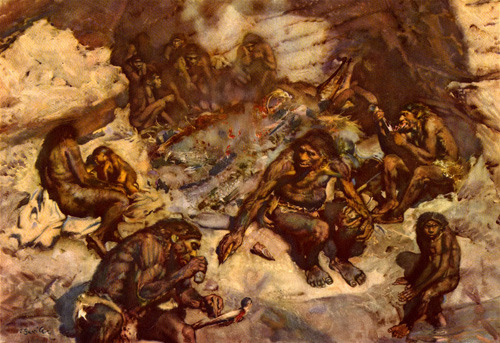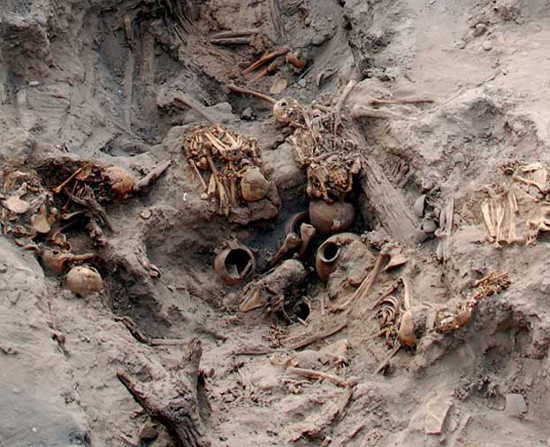10 most archeological findings (2)
These archaeological findings have somewhat clarified the historical questions left open.
Neanderthal cannibals
Scientists have made many assumptions about why Neanderthals lost in the race against the wise Homo Sapiens and went extinct. In this issue, the cannibalism hypothesis makes the number of Neanderthals decline markedly with strong evidence.

Neanderthals are extinct due to cannibalism.
In 2010, human bone fragments dating to about 49,000 years old were excavated at a cave in Spain with numerous marks of human teeth. A group of about 12 people, including 6 adults, 3 young people, two children and an infant were attacked and eaten by a group of Neanderthals.
Earlier, many other archaeological discoveries such as long bones and skulls were crushed for marrow or small pieces of bone fragments, bones with many teeth marks were evidence of Neanderthal's cannibalism.
Sacrifice in the Peruvian temples
In May 2012, at the archaeological site of Pachacamac, near the capital Lima (Peru), Belgian archaeologists unearthed a tomb dating to about 1,000 years with more than a dozen sets of remains and mummies, primarily are babies.
This archaeological site was once a rich land under the rule of Ychsma leaders, then occupied by the Incas to turn into a pilgrimage site before the Spaniards ruled.

The grave represents the sacrificial ritual of ancient Peruvian people.
The tomb is oval-shaped, about 18.3 meters long and is right in front of the Pachacamac temple, quite intact despite many raids. On the outer edge are dozens of remains of babies and young children. The inner ring is about 70 sets of remains arranged in fetal form with items such as ceramic pots, masks, and dolls.
The supposed archaeologist, this tomb area may be a sacrificial ritual or the grave of children who died of disease or injury.
'Vampire' remains
In June 2012, archaeologists discovered two skeletons suspected of being a vampire at a monastery in the town of Sozopol on the Black Sea coast of Bulgaria, home to vampire legends.
Two 800-year-old skeletons with iron bars pierced through the chest are evidence of the common practice in some Bulgarian villages to destroy vampires at its root.

Vampire legend is real?
According to statistics, archaeologists have discovered more than 100 similar remains with the chest pierced with a iron rod in Bulgaria for many years.
According to legend, it was the vampire who was behind the spread of disease throughout the medieval period, typically Black Death caused by the plague that claimed one-third of the European population at that time. The characteristics of the dead because of the epidemic are not well understood and the people think that the zombies are still alive and have enough power to go back to harm the living, so they build legends to eliminate vampires.
The book of the dead
The book of the dead is one of the most mysterious books. It is believed that it contains miracles, mantras of revival and the gateway to the resurrection of the Egyptian priest Amenhotep.
However, the recent announcement in April 2012 affirmed the existence of the Book of the dead, stored in the Queensland Museum (Austrlia) 100 years ago. More than 100 pieces of the book of archaeologists who quit searching, hunting for centuries have appeared unexpectedly, besides some puzzle pieces stored in the pound, Boston Museum of Fine Arts .

"Book of the dead".
Previously, archaeologists could not restore the original state of the book nearly 20m due to lack of many pieces. It has a lot of special drawings, from the 5-star star-shaped border, the solar ground, showing the book belongs to the extremely noble person.
The Vikings 'heads left the corpse'
Dorset County (England) is home to the first Viking military expeditions, as well as fierce battles, looting and destruction. Here, archaeologists discovered a mass grave with about 54 Vikings mercenary bodies, beheaded and buried in shallow graves, one place, one body.
By carbon assessment, the age of skeletons dating from the 11th century. This time, the Vikings repeatedly attacked the Anglo-Saxons on the south coast of the United Kingdom.

Viking's skull.
Dr. Britt Baillie, of Cambridge University, said that the massacre took place under Aethelered's reign of 'Unready'. Accordingly, angry at the Vikings attack, the king ordered the killing of all Danish men living in England. This group of ill-fated Vikings can be imitated by the legendary Harald Bluetooth, the Viking group known for their strict military discipline and never fear.
- Restoring the iron smelting technique that existed 2000 years ago
- 5 terrifying archaeological discoveries related to human sacrifices
- 10 most archeological discoveries (1)
- Dead Sea scrolls and important archaeological findings in 2017
- Scary archaeological findings
- The 10 most remarkable scientific findings of the year
- New findings: Willow leaves can treat 'HIV'
- 'Shocking' findings about your body
- 10 most impressive findings in 2010
- Reveal new findings in ancient Roman city - Pompeii
- Strange findings under the ice layer of Antarctica
- 4 shocking findings on climate change
 Discovered an ancient centipede fossil 99 million years old
Discovered an ancient centipede fossil 99 million years old Discovered bat-like dinosaurs in China
Discovered bat-like dinosaurs in China Discovered a 200-year-old bronze cannon of the coast
Discovered a 200-year-old bronze cannon of the coast Discover 305 million-year-old spider fossils
Discover 305 million-year-old spider fossils